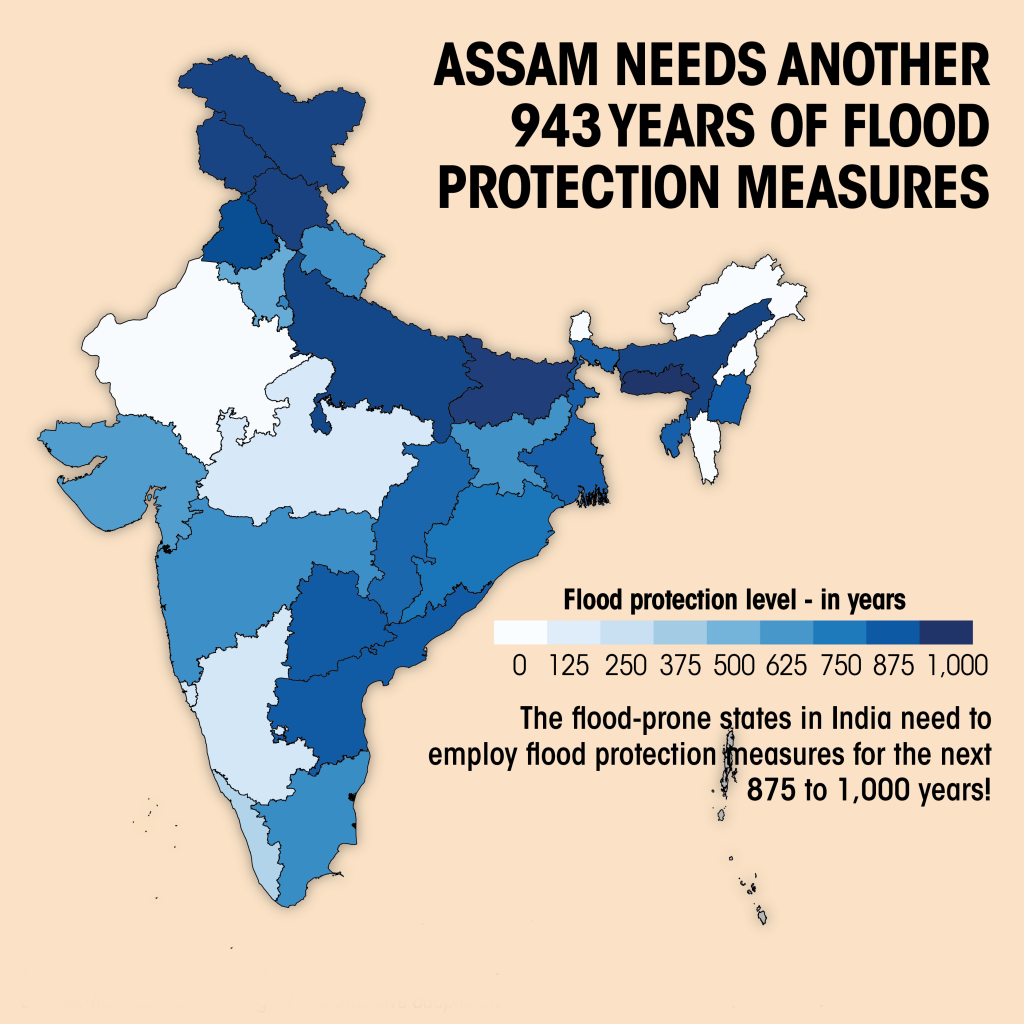Residual Flood Damage under Intensive Adaptation | 25 Jun 2022
For Prelims: Flood Management, NDMA
For Mains: Residual Flood Damage under Intensive Adaptation, Climate Change
Why in News?
According to a new Study published, Residual Flood Damage under Intensive Adaptation, the risk of river flooding is expected to increase with climate change and socioeconomic development.
- Residual flood damage under intensive adaptation tries to estimate the global cost of employing adaptive flood measures depending on local economic scenarios and cost adaptation measures by trying to quantify the cost of Residual Flood Damage (RFD).
What is RFD?
- RFD refers to the unavoidable increases in flood damage even under an adaptation strategy based on feasible adaptation costs.
- Adaptation strategy in the context of floods includes infrastructural measures employed to mitigate flood risks.
- RFD is the part of total Expected Annual Damage (EAD).
- The expected annual damage is the average of flood damages calculated over a number of events.
- It is calculated by subtracted past EAD (1970-2000) and future EAD estimates (set to 1000 years).
What are the Findings?
- Assam will need 943 years of flood protection measures to prevent a crisis like the one it is witnessing if its pace of preparedness and climate adaptation doesn’t increase.
- In 2022, the flooding started as early as May, with 62% above average rainfall from March-May — a 10-year high.
- Currently, 33 of Assam’s 35 districts have been affected due to flooding along the Brahmaputra basin. Over 4.2 million people have been affected by floods this year, while over 100,000 hectares of cropland have been damaged as of June 20.
- Other flood-prone states like Bihar, Uttar Pradesh and Meghalaya will need 966, 935 & 996 years respectively.
- In India, riverine floods — considered one of the major natural disasters — have become synonymous with economic losses. The total flood-related losses in the country were estimated to be over Rs 37 lakh crores from 1953-2017, according to the Central Water Commission.
- RFD in South Asia is estimated to be around USD 4 million and adaptive costs around USD 3 million.
- RFD (as a part of the gross domestic product) remained high in eastern China, northern parts of India and the central regions of the African continent.
- RFD can be reduced with shorter construction periods or lower adaptation costs, implying the need for immediate and appropriate adaptation actions, including enhanced financial support for high-risk regions.
What is Flood?
- About:
- It is an overflowing of water onto land that is normally dry. Floods can happen during heavy rains, when ocean waves come on shore, when snow melts quickly, or when dams or levees break.
- Damaging flooding may happen with only a few inches of water, or it may cover a house to the rooftop. Floods can occur within minutes or over a long period, and may last days, weeks, or longer. Floods are the most common and widespread of all weather-related natural disasters.
- Flash floods are the most dangerous kind of floods, because they combine the destructive power of a flood with incredible speed.
- Flash floods occur when heavy rainfall exceeds the ability of the ground to absorb it.
- They also occur when water fills normally dry creeks or streams or enough water accumulates for streams to overtop their banks, causing rapid rises of water in a short amount of time.
- They can happen within minutes of the causative rainfall, limiting the time available to warn and protect the public.
- Measures:
UPSC Civil Services Examination, Previous Year Question (PYQ)
Q. La Nina is suspected to have caused recent floods in Australia. How is La Nina different from El Nino? (2011)
- La Nina is characterized by a usually cold ocean temperature in equatorial Indian Ocean whereas El Nino is characterized by unusually warm ocean temperature in the equatorial Pacific Ocean.
- El Nino has adverse effect on south-west monsoon of India but La Nina has no effect on monsoon climate.
Which of the statements given above is/are correct?
(a) 1 only
(b) 2 only
(c) Both 1 and 2
(d) Neither 1 nor 2
Ans: (d)
Exp:
- Normally, when the tropical eastern South Pacific Ocean experiences high pressure, the tropical eastern Indian Ocean experiences low pressure. But in certain years, there is a reversal in the pressure conditions and the eastern Pacific has lower pressure in comparison to the eastern Indian Ocean. This periodic change in pressure conditions is known as the Southern Oscillation (SO).
- A feature connected with the SO is the El Nino phenomenon in which a warm ocean current flows past the Peruvian Coast, in place of the cold Peruvian current, every 2 to 5 years. The presence of El Nino leads to an increase in sea-surface temperatures and weakening of the trade winds in the region. Hence, statement 1 is not correct.
- The result of El Nino is:
- Rain on the western coast of South America
- Drought in Northern Australia, Indonesia and India
- Storms and Hurricanes in the East Pacific
- Coral bleaching
- The La-Nina episode represents periods of below average sea-surface temperature across the east central Equatorial Pacific.
- Global climate La Nina impacts tend to be opposite those of El Nino impacts. In the tropics, ocean temperature variations in La Nina also tend to be opposite those of El Nino. Hence, statement 2 is not correct.
- During La Nina, things are same as in a “normal” year, but the two things – Cold Peru Current and Trade Winds become even “stronger”. This results into too many fishes on the Peruvian coast and too much rain in Indonesia and Australia.
- Therefore, option (d) is the correct answer.

